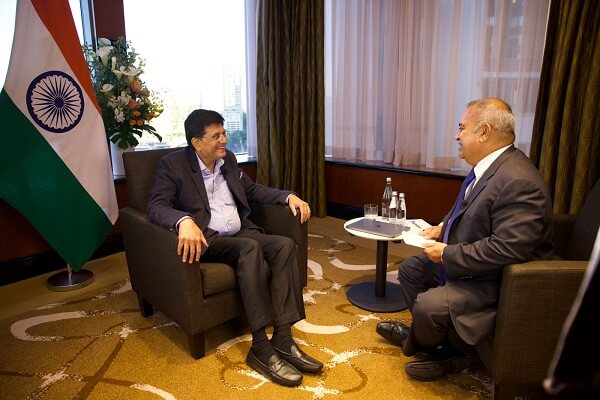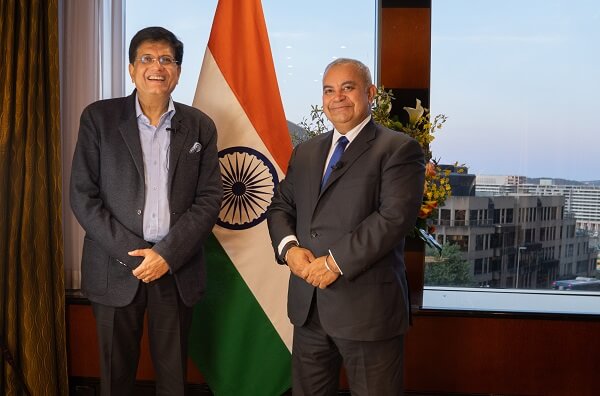Pawan Luthra: Minister Piyush Goyal, thank you very much for joining us on Indian Link. You were appointed as Minister of Commerce and Industry in June 2019. The latest World Bank report has said that India remains the world’s fastest growing major economy, growing at a rapid rate of 8.2% in financial year 2023-2024, while the manufacturing sector grew by 9.9%. There’s a bit of Indian in me coming out here – where did we lose the 0.1%, because 10% would have been wonderful! (Both laugh). Now, is that a very good five-year report card?
Piyush Goyal: Well, I think India is hungry for more. We are never satisfied with what we achieve. We have a long way to go because there’s a lot of catch up to do. There were decades of lost opportunity that we inherited. When in 2014 Narendra Modi became the Prime Minister, India was considered a ‘fragile five‘ economy, one of the weakest five in the world.
Over the last 10 years, we’ve painstakingly strengthened the macroeconomic fundamentals. We have carefully administered reform in the country, focused on transforming the mindset of the people. Today, we are not only the world’s fifth largest GDP, we have low inflation, about 3.5- 3.6%. We have a situation where we have the world’s fourth largest foreign currency reserves, $689 billion. Very low external debt, so we are not at risk. The currency is stable, and amongst the large economies, we’re the fastest growing economy for many years in a row, expected to continue to be the fastest growing for many years in the future. Piyush Goyal in Sydney
So we are at a sweet spot, but we are never one to be satisfied.
Pawan Luthra: A recent report from Bloomberg pointed out that Apple manufactured iPhones worth about $14 billion in India during financial year 2023-24, which is 14% of the global exports. They plan to take it up to 25% in the next four years, earning India about $25 billion more. There’s an enormous faith in the India story, while also a pivot away from China. Your thoughts on the Apple manufacturing story? And, is the manufacturing rivalry between India and China now moving into India’s favour?
Piyush Goyal: First of all, I must compliment Apple for its bold decision.
PM Modi introduced the Production Linked Incentive Scheme, recognising that we have competitive strengths in certain industries. We identified 14 different emerging sectors, and carefully analysed the cost competitiveness and why we were losing out on business opportunity. That was a move that turned out to be very positive for India. We are today the world’s second largest mobile phone manufacturer, with over 200 factories producing phones or the ecosystem around phones, whereas we had only two 10 years ago.
The Apple story has truly been a success story. Electronics export today is our third largest export, thanks to large measure to the efforts of companies like Apple. We have now introduced the Semicon mission also, so we’ll have a greater domestic value add for all the phones that Apple makes. The big advantage in the India growth story is that we also present a huge domestic demand – 1.4 billion people is a very compelling case – with the rule of law, democracy that we are very proud of. You have a reformist, decisive government; a leader who can take firm decisions; a very good demographic dividend; young population with skill and talent, and people willing to work hard. In fact, I’m told 70 or 80% of the workers in the Apple factory are women.
So all of these put together with the large demand that India provides in the growing middle class, has encouraged Apple to expand operations in India. Many other countries and companies around the world are seriously looking at the India story. It’s not as if it’s just a China plus one story for people coming to India.
We are an emerging economy that aspires to be 10x in the next 25 years. We‘re about $3.5 trillion (currently), we want to go up to $30-35 trillion by 2047 when we celebrate 100 years of Independence. This growth opportunity has never been witnessed in humanity or in human history ever before. Piyush Goyal in Sydney
Pawan Luthra: But there are issues with youth unemployment, aren’t there?
Piyush Goyal: It’s a matter of how you look at unemployment. Clearly, we would like to see better quality of employment. We would like to see more people to the formal workspace.
But it’s not as if everybody is without a job, or there are too many people are without a job. Larson and Toubro, one of our largest infra companies the other day announced that they’re looking for 45,000 more people! And in the same company’s IT setup, Mindtree, they’re looking for 25,000 more people. Just one company in two of their divisions, Infra and IT, is looking for 70,000 people.
You’ll hear this story across India.
Pawan Luthra: Minister, you’re keen to make a strong case for India to become a Taiwan plus one semiconductor country, in which India can be a place for companies to diversify outside of Taiwan for semiconductors. In 2021, India had approved a US $10 billion incentive plan to attract semiconductor chip makers. Three years down the track, how’s that tracking?
Piyush Goyal: I think it’s one of the success stories of India. A large part of that money has already been committed. We had the Tatas setting up with the Taiwanese company Fab in Assam. Micron has come to Gujarat. I think Applied Materials has also decided to come in. As one company comes in, the entire ecosystem gets attracted. And the semiconductor industry – I’ve been engaged with them for some time now – continuously tells me, don’t be in a rush. This is a process. First, the design guys come in, then the Amp guys come in, you have the packaging happening. The ecosystem builds up over a period of time.
And that’s when you finally start seeing the moving in in a big way. So we can clearly see those ecosystems developing in different parts of the country. We can clearly see that they recognise India as a growing market.
Our estimated semiconductor consumption is about $109 billion by 2030 – it’s going to be a big market. We have the talent, we have the skillsets in our workers. And if you look at semiconductor companies across the world, a large part of their talent pool is Indian!

Pawan Luthra: The World Bank report card I referred to earlier pointed out that lowering the trade barriers can help India achieve its ambitious target of $1 trillion for merchandise exports by 2030. Do you feel India is doing enough in lowering trade barriers to achieve these goals, especially in the areas of the retail sector and the dairy industry?
Piyush Goyal: Well, there will be some trade barriers which are necessary to protect sections of Indian industry or farmers. Dairy for one is an area where I have very small farms and the farm owner has two or three livestock, producing a small quantity of milk or dairy. I have to protect them because they really can’t compete with the large farms with thousands of animals and stuff like that. Certain sectors deserve and will always require some trade barriers.
On many sectors, we are entering into free trade agreements with different countries. We are working on reducing trade barriers as long as they are reciprocated by the countries on the other side. It can’t be a unilateral action.
So we are working with countries to see what we can do to further strengthen relationships and bilaterally improve the trading conditions. Of course, on a macro level also, there are many major changes being made, for example, to encourage a particular sector we wanted to encourage, such as leather or apparel industry. So you then keep reducing the trade barriers of those sectors.
It’s a cat and mouse game. There are some offensive interests, some defensive interests. You have to carefully navigate them. Piyush Goyal in Sydney
Pawan Luthra: Minister, now please allow me to use a Facebook analogy. In September 2021, when the Economic Cooperation and Trade Agreement, ECTA, was agreed on, both India and Australia changed their Facebook status from ‘friends ‘ to ‘in a relationship‘. Almost three years down the track, this mutual status has yet to be changed to ‘engaged‘, by finalising the next step of signing off on the Comprehensive Economic Cooperation Agreement CECA. Can you share with us a timeline on the CECA sign off? And what is holding it back?
Piyush Goyal: I think there’s a great trust and sincerity of purpose in the work that Australia and India are doing to finalise this agreement. India went into election mode this year.
And now I have elections in my home state Maharashtra. So a little bit of an election year in India this year, and (it will be the same) next year here in Australia.
So I think that’s delayed it a little bit. There’s no lack of intention. And both my good friend, brother and colleague, Don Farrell and I are committed to concluding the final stage of the ECTA agreement. At the earliest. We never put deadlines or dates or a gun to the head to negotiate. There are certain issues where both sides have to take a call, you know, MRAs, Mutual Recognition Agreements on the services sector. So we ultimately have to come up with fair and balanced agreements. And both sides have to give some and take some. It’s always necessary to give elbow room and try to get the best deal which is in the interest of the people and businesses of both sides.
Pawan Luthra: It is clear that government-to-government engagement is very strong between India and Australia. You’ve had meetings with Centre for Australia India Relations, Business Council of Australia, Macquarie Bank and others today. Are you heartened by the level of corporate engagement? How has it changed since your last visit to Australia?
Piyush Goyal: Well, I’ve had a wonderful day ever since I flew into Sydney. It’s been back-to-back meetings.
I haven’t had a full meal also, because we were talking over a working lunch… but I’ve thoroughly enjoyed meeting friends from the business world, from the investment world, the super funds, tourism related. I just had a meeting with the Cruise Liners Association, and before that with the Miners Association to get a macro feel of where we can cooperate and expand relations. The Australian people are very, very easy to work with, very friendly, and I think all these engagements will result in further strengthening our bonds.
Had a wonderful meeting with the Hon’ble Premier of NSW Australia, Mr. Chris Minns at the historic Parliament in Sydney.
Invited him to visit India along with a Business and Parliamentary delegation.
Grateful for his appreciation on the success of India-Australia Economic… pic.twitter.com/b2dhBI9IGI
— Piyush Goyal (@PiyushGoyal) September 24, 2024
The relationship post ECTA has been good. We’ve been seeing growing trade, increasing participation in the services sector. After that, the double taxation agreement was improvised.
We could do better with tourism numbers. The common refrain in all meetings is more flights, direct flights to Australia from India. But that’s an international problem.
We have a shortage of aircraft worldwide. Piyush Goyal in Sydney
Pawan Luthra: Yes, I spoke to Campbell Wilson only recently, the CEO and MD of Air India. And though he’s getting a delivery of one plane every six days, he’s assured me that there’s nothing spare to be sent to Australia in the near future.
Piyush Goyal: The demand is just crazy. India is going to be the world’s largest purchaser of aircraft for the next probably 20 or 30 years. And already this decade, we are the largest buyer.
So I can clearly see tourism becoming one of the mainstays of this relationship. Technology is another very important element of this partnership. ITTT – investment, trade, tourism, technology – is going to be at the frontier of our work with Australia. And I’m hoping very soon to start an office to promote tourism, trade, investments, technology flow through Invest India, the Director General of Foreign Trade, a single stop shop for industrial land or for one stop approval of all kinds. We’re trying to create a setup in one of the cities in Australia.
Pawan Luthra: Sydney, I hope. Piyush Goyal in Sydney
Piyush Goyal: I hope it’ll be Sydney. The decision will be taken in consultation with industry.
Pawan Luthra: One thing you haven’t spoken about, is education. Education is a significant trade between India and Australia. But recently, the government has cut down on numbers. What are your thoughts on that?
Piyush Goyal: Well, I think that’s counterproductive from the Australia perspective, because the Indian students who come here bring in a lot of value in terms of education as well as the value proposition to the Australian economy, even in their post-student days. They are also peace-loving, not a community which has ever hurt or harmed the local community in any way.
But that is a sovereign decision that Australia will have to take. My own sense is the universities will hurt, their revenues will be down. And you may actually have a shortage of manpower in this country.
Pawan Luthra: Tell us a bit about your relationship with Prime Minister Tony Abbott.
Piyush Goyal: My friendship with all the senior leaders of Australia have been phenomenal. Tony Abbott was amongst the first big leaders to come to India when we took office in May 2014.
I was his minister-in-waiting so I received him at the New Delhi airport – He’s such a pleasing personality, such an easy person to get along with. I’ll share with you one of his first comments after I introduced myself and welcomed him to India. His first question, comment or demand, whatever you want to call it, was, Piyush, can you get me a yoga session with Prime Minister Modi?
I was flummoxed – just didn’t know what to say!
But he’s a wonderful leader, a tremendous human being, full of energy, and full of confidence about the Australia-India partnership. He’s somebody whom I’ve always admired for being the champion of the Australia-India friendship partnership.
After that, I’ve worked with both Mr. Morrison and with Mr. Albanese, both remarkable leaders of substance. I’ve had to work with several Australian ministers because I’ve had portfolios which were very relevant to Australia – coal, mining, renewable energy, powers, all the energy, various portfolios. But I can only tell you, I’ve enjoyed working with the Australian leadership over the years.
Current Trade Minister Don Farrell is an outstanding human being and a dear friend. I’m looking forward to my visit to Adelaide day after tomorrow, when I’ll be meeting him and his family. All in all, the friendship between Prime Ministers of Australia and India, ministers at different levels, the people at the frontier of this relationship, we have a great future ahead between Australia
Pawan Luthra: Minister Farrell has often talked ab.out the lavish feast you laid out for him the last time he was in India. My last question for you – did Mr Abbott get that yoga session with Mr Modi? Piyush Goyal in Sydney
(Laughing) Raaz ko raaz he rehne do (Let that remain a secret). Prime Minister Modi (keeps) his personal life very private. But the good part is that Mr Abbott’s daughter today is a wonderful yoga instructor. So I think there’s something which has caught on!
View the interview here





